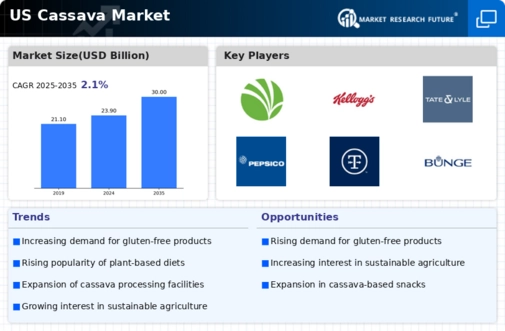Expansion of Food Applications
The versatility of cassava is a significant driver in the cassava market. It is utilized in various food applications, including snacks, flour, and beverages. The increasing incorporation of cassava in processed foods is noteworthy, as manufacturers seek to diversify their product offerings. In the US, the market for cassava-based snacks is expanding, with a projected growth rate of around 8% annually. This expansion is indicative of the growing consumer preference for innovative and diverse food products. Additionally, cassava flour is being adopted in baking and cooking, appealing to both health-conscious consumers and those with dietary restrictions. The adaptability of cassava in different culinary contexts enhances its market potential, suggesting a robust future for the cassava market.
Increasing Health Consciousness
The growing awareness of health and nutrition among consumers is driving the cassava market. As individuals seek healthier alternatives to traditional grains, cassava, known for its gluten-free properties, is gaining traction. In the US, the demand for gluten-free products has surged, with the market projected to reach approximately $7 billion by 2026. This trend indicates a shift towards healthier eating habits, which is likely to benefit the cassava market. Furthermore, cassava is rich in carbohydrates and provides essential nutrients, making it an attractive option for health-conscious consumers. The increasing prevalence of dietary restrictions, such as celiac disease, further propels the demand for gluten-free options, positioning cassava as a key player in the evolving food landscape.
Rising Ethnic Cuisine Popularity
The increasing popularity of ethnic cuisines in the US is contributing to the growth of the cassava market. As consumers become more adventurous in their food choices, they are exploring traditional dishes that incorporate cassava, particularly from African and Asian cultures. This trend is reflected in the rising demand for cassava-based products, such as tapioca and cassava flour, which are essential ingredients in many ethnic recipes. The US market for ethnic foods is expected to grow by approximately 10% over the next few years, indicating a strong interest in diverse culinary experiences. This cultural shift not only enhances the visibility of cassava but also positions it as a staple ingredient in various cuisines, thereby expanding its market reach.
Government Support and Policy Initiatives
Government support and policy initiatives are increasingly influencing the cassava market. In the US, various programs aimed at promoting sustainable agriculture and food security are likely to benefit cassava producers. Financial incentives and grants for research and development in cassava cultivation can enhance productivity and market access. Additionally, policies that encourage the use of alternative crops, such as cassava, in food production may lead to increased investment in this sector. The US government has recognized the potential of cassava as a food source, which could result in favorable regulations and support for farmers. This proactive approach may stimulate growth in the cassava market, ensuring its relevance in the agricultural landscape.
Technological Advancements in Agriculture
Technological innovations in agriculture are playing a crucial role in enhancing cassava production efficiency. The adoption of precision farming techniques and improved crop management practices is likely to increase yields and reduce production costs in the cassava market. In the US, advancements in biotechnology are being explored to develop cassava varieties that are more resilient to pests and diseases. This could potentially lead to a more stable supply chain and lower prices for consumers. Furthermore, the integration of data analytics in farming practices allows for better decision-making, optimizing resource use. As these technologies continue to evolve, they may significantly impact the cassava market, fostering growth and sustainability.

















Leave a Comment